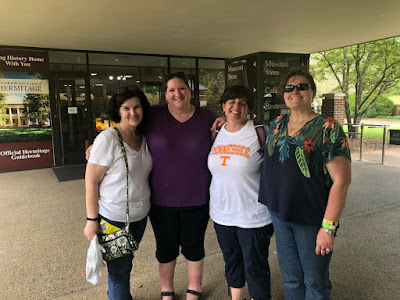By Ramona Shelton
Motlow Buzz Managing Editor
The sound of bagpipes… the plaids of the
kilts… the corgis roaming. These are all things you would equate with the
Highlands of Scotland rather than Nashville, Tennessee, but the two worlds collided
at Andrew Jackson’s Hermitage on Sept. 8, 2018, and Motlow Smyrna was there to
see it all!
This was the fourth year the Middle
Tennessee Highland Games were held on the grounds of Andrew Jackson’s
Hermitage, and plans are already being made for the 2019 event next summer.
Motlow attendees this year included current Motlow student Kayla Dyer, Motlow
alumni Brittany Jones, Financial Aid guru Donna Dunaway and her family,
Professors Stacy Dowd, Tamara Jones, and Ramona Shelton, as well Smyrna
librarian extraordinaire Paige Hendrickson, and Motlow Smyrna’s own academic
first family, the Fitches.
 |
| Ramona Shelton, Paige Hendrickson, Stacy Dowd, and Tamara Jones (left to right) attended the Middle Tennessee Highland Games at Andrew Jackson's Hermitage in Nashville. |
The Middle
Tennessee Highland Games began in 2014 for charitable, educational, social
and athletic purposes. The idea was to create a forum in which the general
public could come together to learn, appreciate and preserve Scottish and
Celtic culture. In addition to the Highland traditions, the games also support
Operation Restored Warrior, a non-for-profit organization that is dedicated to
helping soldiers returning home to Middle Tennessee deal with PTSD and the
stress of combat. The idea of the MTHG partnering with Operation Restored
Warrior comes from the 1320 Scottish Declaration of Arbroath.
“For as long as a
hundred of us remain alive, we will yield in no least way… For we fight, not
for glory nor for riches, nor for honours, but only and alone for freedom,
which no good man surrenders but with his life.”
Festivities started off with recognition
of several veterans from all branches of the military who were a part of
Operation of Restored Warrior. They were given the opportunity stand front and
center as the national anthem was played.
 |
| (Photo from the Middle Tennessee Highland Games website) |
Following this honoring and humbling
recognition, it was time to let the clans represent! The Presentation of the
Clans occurred when the clans all gathered and marched in front of the Master
of the Games. This year’s honored clan was Clan Campbell, a group having their
Annual General Meeting as a part of this event. As the clans walked through the
athletic field in alphabetical order, each showed their clan tartans and
presented their flags and swords to the master. Dozens of clans were
represented with not only Clan Campbell but also Clan Stewart, the Royal Clan,
and the Clan of the Hero, Clan Wallace, being specifically recognized.
 |
| (Photo from the Middle Tennessee Highland Games website) |
Outside of the formal clan
presentations, each clan also had areas set up along the festival grounds where
attendees could learn more about the family. Kayla Dyer, Motlow Smyrna student
and charter member of the History Club, learned that her family name was a
subset of Clan Davidson. If you are interested in discovering any Celtic roots
your family may have, check out www.midtenngames.com for info on
the clans presented at the event.
Of course, no gathering of the braw
Scottish lads and lassies would be complete without the tests of strength so
common to any Scottish gathering! Participants were broken into three groups:
women, men under 40, and men 40-plus, and it is safe to say that muscles abounded!
These amateur athletes participated in several events traditionally seen in the
true annual games in the Scots Highlands. These included the stone put, similar
to the shot put but using a 28-pound and 56-pound stone or rock rather than a
steel ball. During the hammer throw, the announcer and judge often warned (in a
joking manner) the crowd to be ready to duck if the throw went wild. Joking or
not, this advice should be taken seriously because this event entails the
thrower grasping a 3-foot 11-inch rope with a 16-pound (men) or 8-pound (women)
weight at the end, do three or four increasingly fast circular rotations to
build momentum, and then let the hammer fly to see who could get the most
distance. Considering that our group was sitting directly behind the throwing
point, we took the ducking advice seriously.
 |
| (Photo from the Middle Tennessee Highland Games website) |
Arguably the two events most impressive
in the true Highland competitions were just as spectacular when translated into
our Middle Tennessee venue. The sheaf toss is an event in which a burlap sack
filled with 16 pounds of hay is grabbed by a pitchfork and tossed over a bar.
For those who cleanly get the sack over (not touching the bar) in round one,
advancement to successive rounds means an ever-increasing height on the bar. Of
all the events, this one seemed to be essentially the same whether the
competitor was male or female.
If you thought throwing a 16-pound bag
of hay wasn’t interesting enough, the caber toss would be the event for you.
Caber is derived from “cabar,” the Gaelic word for a wooden beam. In the
Highlands, this beam is typically carved from a Larch tree and is 19 feet 6
inches long. I’m not sure if the caber used here was from Larch wood, but they
definitely got the height the same. Competitors hoisted the telephone-pole like
beam up and cast it end over end to see who could throw it the farthest. If a
viewer got anything from any of these events, the takeaway is “don’t mess with
someone who knows Scottish athletic events. They can whip you up with a
telephone pole!”
If you are interested in finding out more
about the games, the clans, or Operation Restored Warrior, check out www.midtenngames.com.

No comments:
Post a Comment